John Tukey was amazingly talented. He would have been remembered for his achievements in pure mathematics had he not gone on to have an even more remarkable career in statistics. He is also remembered for some of the words he coined, such as “software” and “vacuum cleaner.”
In his book Exploratory Data Analysis, affectionately known as EDA, Tukey gives advice on collecting and analyzing data, even down to how to count observations. Rather than the usual slash tallying, Tukey recommended his own method of tallying.

Tukey’s system is easier to scan and may be less error-prone. For example, compare a count of 36 in both systems.
![]()
![]()

There’s a standard system in Chinese to do this. I can’t remember it exactly but it seems to work pretty well for them.
In Japanese I have seen tallying using the kanji for 5, which is the same in Chinese. There are 5 lines to make the character for 5, and a defined stroke order for each one, so you always know where you left off.
Wikipedia has it (the Chinese version):
http://en.wikipedia.org/wiki/Tally_marks
No, Ben, not the kanji for “5” (五), but the one for “correct” (“tadashii”, or 正). The character for 5 actually has four strokes, counting the third “over and down” stroke as one; no Japanese would ever consider this two strokes or break it in two when writing. The “correct” character, on the other hand, has exactly five strokes and it is trivial to see at a glance what the current count is (the order is top horizontal, middle vertical, right horizontal middle line, left vertical line, and bottom line). I’m most familiar with its use at bars to count the number of carafes of sake I have had.
The link Dennis gives shows this.
I learned to encircle two groups of five, to make it easier to identify each group of ten. I think this make identification of the number on par with Tukey’s method.
John,
The method you credit to Tukey was around in forestry it seems well before his use. See Forest mensuration By Carl Alwin Schenck, 1898 pg 47
Google Books has it
perhaps you should warn the younger, less educated reader that most of this book is about stuff that became irrelevant with personal computers..or certainly, with, say windows2000+web+excel
eg, alot of this is about how to look at data when you don’t have the instant graphs and stat functions of excel
imo
Ezra Abrams,
Two thoughts, I think reading Tukey is as much about statistical ideas as graphical methods, and he is (in my opinion) still well worth reading.
Also, if you ever worked on a hot messy machine shop floor with cutting oil at every station, your high tech equipment may have a very short life, and a very high price tag.
Not sure I’m ready to declare Tukey “irrelevant”.
Lovely.